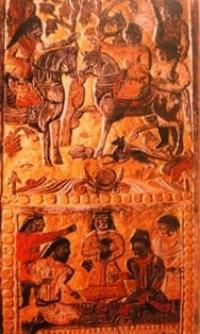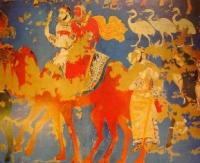Вы здесь
Ancient Khorezm.



Tours over monuments of ancient Khorezm.
«Having been abandoned for more than three centuries, and then used as a graveyard, the area has remained relatively intact. Accordingly, Kunya-Urgench is considered to have retained its integrity better than most other sites in Central Asia as the attributes of the property are still present. The authenticity of the property has been preserved in the site layout and the use and the function of the site as a religious centre which is still continuing. It is also preserved as a prominent pilgrimage centre of Islam»
Travel across Khorezm and Central Asia.
It was the center of the Iranian Khwarezmian civilization and a series of kingdoms such as the Persian Empire, whose capitals were Kath, Gurganj and – from the XVIth century on – Khiva. Today Khwarezm belongs partly to Uzbekistan, partly to Kazakhstan and partly to Turkmenistan, Khwarezm has been known also as Khorezm, Horezm.
Bosworth, however, believes the Persian name to be made up of and zam, designating the land from which the sun rises, another view is that the Iranian compound stands for lowland from khar low and zam land. Khwarezm is indeed the lowest region in Central Asia, located on the delta of the Amu Darya on the shores of the Aral Sea.
Some of the early scholars believed Khwarezm to be what ancient Avestic texts refer to as Airyanem Vaejah. These sources claim that Old Urgench, which was the capital of ancient Khwarezm for many years, was actually Ourva, the eighth land of Ahura Mazda mentioned in the Pahlavi text of Vendidad.
Al-Biruni starts giving names only with the Afrighid line of Khwarazmshahs, having placed the ascension of Afrighids in 616 of the Seleucid era, like Soghdiana, Khwarezm was an expansion of the culture during the Bronze Age which later fused with Indo-Iranians during their migrations around 1000 BC.
Early Iron Age states arose from this cultural exchange, ruled by the native Afrighid Dynasty. It was at point that Khwarezm entered the historical record with the Achamenid expansion. An East Iranian language, known as Khwarezmian language, was spoken in Khwarezm proper until soon after the Mongol invasion and it was closely related to Sogdian.
In the very part of its history, the inhabitants of the area were from Iranian stock. Sometime before the Achaemenid king Cyrus the Greats death in 530 BC, while he was dying, he appointed his son Smerdis Bardiya as the governor of the region, along with Bactriana, Carmania, and the other eastern provinces of the empire. And the Persian poet Ferdowsi mentions Persian cities like Afrasiab and Chach in abundance in his epic Shahnama, the kings emissary offered to lead Alexanders armies against his own enemies, west over the Caspian towards the Black Sea.
Although largely independent during the Seleucid, Bactrian and Arsacid dynasties, it is known that Khwarezm, yaqut al-Hamawi verifies that Khwarezm was a regional capital of the Sassanid empire. It was also vassal kingdom during periods of Kushans, Hephthalites, the Afrighids were a native Chorasmian dynasty which ruled over the kingdom of Khwarezm from 305 until 995 A. D.
Sometimes it was under Sassanid control, in 712 Khwarezm was conquered by the Arab Umayyads. In 995, they overthrew the Afrighids of Kath and themselves assumed the traditional title of Khwarazm-Shah. Briefly, the area was under Samanid suzerainty, before it passed to Mahmud of Ghazna in 1017, in the XIIth century, the Khwarezmid Empire was founded and, in the early XIIth century, ruled over all of Persia under the Shah Ala al-Dīn Muhammad II.
Источник:
https://ru.wikipedia.org







